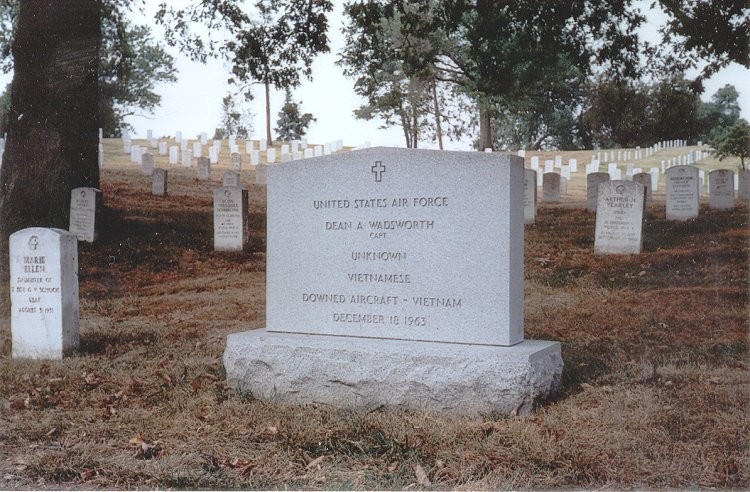Dean Amick Wadsworth was born on November 30, 1930 and joined the Armed
Forces while in Clarendon, Texas.
He served in the Air force. In 12 years of service, he attained the rank of Captain. He
began a tour of duty in Vietnam on October 8, 1963.
DEAN AMICK WADSWORTH is listed as Missing in Action.
Wadsworth, Dean Amick
Born 10 November 1930, Died 18 December 1963
US Air Force, Captain
Res: Devine, Texas
Section 34, Grave 1153, buried 3 June 1999
ADSWORTH, DEAN AMICK
REMAINs IDENTIFIED 04/16/99
Name: Dean Amick Wadsworth
Branch/Rank: United States Air Force/O3
Unit:
Date of Birth: 30 November 1930
Home City of Record: CLARENDON TX
Date of Loss: 08 October 1963
Country of Loss: South Vietnam
Loss Coordinates: 0 0
Status (in 1973): Killed In Action/Body Not Recovered
Category: 2
Aircraft/Vehicle/Ground: T28
Missions:
Other Personnel in Incident: South Vietnamese crewman Refno:
REMARKS: ACFT BROKE UP CRASH EXPLODED
CACCF/CRASH/PILOT/12 YRS UNITED STATES AIR FORCE/QUANG NAM
No further information available at this time.
No. 057-M
MEMORANDUM FOR CORRESPONDENTS April 16, 1999
The remains of six American servicemen previously unaccounted-for from the war in Southeast Asia have been identified and are being returned to their families for burial in the United States.
They are identified as Air Force Capt. Dean A. Wadsworth, Clarendon, Texas; Marine SSgt. Harold E. Reid, Salt Lake City, Utah; Navy Lt. David L. Hodges, Chevy Chase, Md.; Air Force Lt. Col. Lewis M. Robinson, Saginaw, Mich.; Air Force Capt. Douglas K. Martin, Tyler, Texas; and Air Force Capt. Samuel L. James, Chattanooga, Tenn.
On October 8, 1963, Wadsworth and his South Vietnamese crewman were flying their T-28B Trojan on a combat support mission approximately 50 miles southwest of Da Nang, South Vietnam. As he completed his bombing run over the target, his aircraft broke apart in mid air, crashed and exploded, as reported by another pilot on the mission. A massive search and rescue operation was initiated that day by two Marine helicopters but they disappeared during the mission. At dawn on the following day, Marine helicopters airlifted two companies of South Vietnamese infantrymen to the
area of the downed aircraft. As the helicopters landed, enemy troops fired on them, wounding three Marine crewmen and killing a Vietnamese soldier.
Two T-28s, B-26s and a South Vietnamese A-1 aircraft responded by strafing enemy positions. An American L-19 light observation aircraft directing the strike was hit, the Vietnamese observer was wounded, and the aircraft made a forced landing. Meanwhile, the Vietnamese ground troops found both Marine helicopters that had disappeared on the first day. Ten bodies were recovered, but two remain missing in action to this day. In the days during the search and rescue operations, 207 missions were flow n, three aircraft were lost and four others damaged. Fifteen South Vietnamese soldiers were killed and seven were wounded.
In late 1993, a Vietnamese local turned over remains he said were recovered near the crash site. In May of the following year, a joint U.S./Vietnamese team, led by the Joint Task Force-Full Accounting, visited the area of the crash, interviewed villagers and obtained some aircraft debris and pilot-related equipment. In September, another joint team examined the crash site and found more debris, but no remains. Then in May 1995, another team excavated the site where they found remains, as well as two identification tags of Wadsworth.
Michael Robert Patterson was born in Arlington and is the son of a former officer of the US Army. So it was no wonder that sooner or later his interests drew him to American history and especially to American military history. Many of his articles can be found on renowned portals like the New York Times, Washingtonpost or Wikipedia.
Reviewed by: Michael Howard


